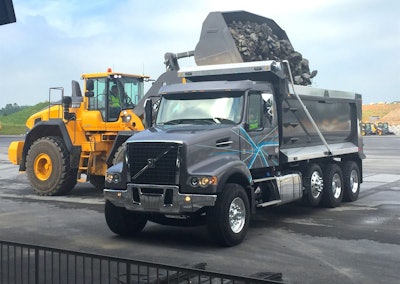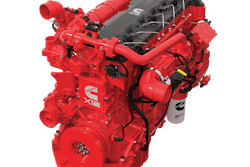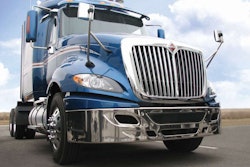 Volvo Trucks is one of the manufacturers that have refused to use an aluminum cab, citing driver safety as its reason for sticking with steel construction.
Volvo Trucks is one of the manufacturers that have refused to use an aluminum cab, citing driver safety as its reason for sticking with steel construction.Ford shaved 750 pounds from its flagship F-150 pickup for model year 2015 by converting much of the steel body to aluminum. For 2017, Ford will apply a similar strategy to its beefier Super Duty line.
Last week, the U.S. Environmental Protection Agency (EPA) and the U.S. Department of Transportation’s National Highway Traffic Safety Administration (NHTSA) threw down the gauntlet for slashing heavy-truck emissions and boosting efficiency and cited aluminum components including wheels, extrusions and sheet as part of the light-weighting solution. The agencies’ Phase 2 rule requires trucking efficiencies to improve up to 25 percent by 2027 in an effort to cut greenhouse gas (GHG) emissions from U.S. freight transportation activities, with just north of 5 percent of those gains coming from engine performance.
“We’re pleased that the agencies recognized the contribution that aluminum—along with other lightweight material solutions—can play in helping OEMs meet the ambitious new targets set out in the rule” says Curt Wells, director of regulatory affairs at the Aluminum Association.
RELATED >> Truck, engine makers and industry groups pleased with final Phase 2 emissions standards
Research conducted by Ricardo Consulting Engineers suggests an “aluminum-intensive” Class 8 commercial tractor-trailer could reduce vehicle weight by 3,300 pounds. For every 10 percent of weight reduction, the group says up to a 5.5-percent improvement in fuel economy is possible.
The study also found that outfitting the nation’s fleet of Class 8 tractor-trailers with aluminum-intensive models would save 9.3 million tons of CO2 annually, almost 1 percent of Phase 2’s approximately 1.1 billion ton target.
Concessions will have to be made in many cases in the Class 8 market. Even when Ford introduced aluminum into its Super Duty, they doubled down on steel in truck’s backbone. While F-150 shed nearly 38 percent of a ton in the aluminum conversion, Super Duty saw about half that thanks to a more rigid steel frame—a move that helped rocket Super Duty to best in class towing.
Aluminum’s infiltration into trucking may not be as easy, nor as revolutionary, as its conquest of Ford’s F-Series.
Freightliner, for example, introduced the first all-aluminum cab in 1942 and now all its on-highway tractors feature one. Peterbilt has been using an aluminum cab for more than a generation. Volvo, Mack and Western Star are among the last of the steel holdouts.
RELATED >> Inside the 2017 F-250 King Ranch: Ford’s Super Duty trucks get bigger and lighter
“All Volvo Trucks—highway, regional and vocational—have cabs made of high strength steel,” Volvo Trucks’ Product Marketing Manager Jason Spence says. “This is key to the safety and protection of the driver in the event of a collision.”
Metallic substitutions may find the most traction in truck wheels, where a conversion to aluminum is already underway.
Timothy Weir, Accuride’s director of public affairs, says aluminum wheels already make up nearly 50 percent of the company’s total wheel sales, a trend he expects to trend continue in the march toward model year 2027.
But just as Ford found use for heavier steel in the Super Duty truck frame, Weir says steel’s role in truck wheels is secure even as it loses market share.
“Steel wheels will always play an important role within the commercial vehicle industry,” he says, noting that aluminum wheels also come with a price premium. “In addition, certain market segments simply don’t benefit from the specific characteristics aluminum wheels offer.”
Aluminum aside, Accuride has also worked to develop lighter weight steel, and the company’s steel wheels are among the lightest in the industry.
“And we continue to introduce advanced lightweight steel wheels that help to improve fuel economy at prices considerably less than the prices for aluminum wheels,” Weir adds.













